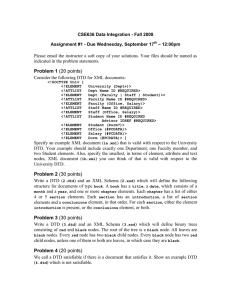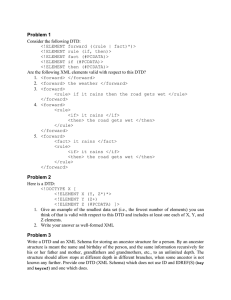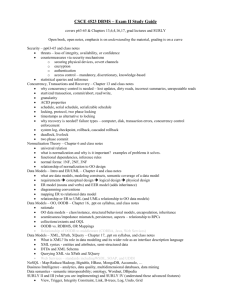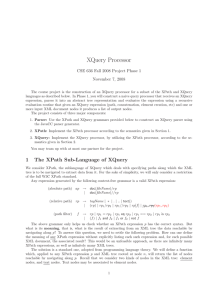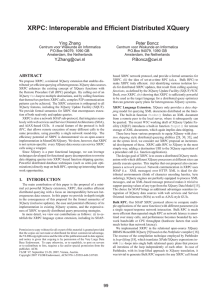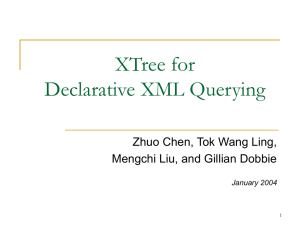CSE636 Data Integration - Fall 2008 – 12:00pm (in class)
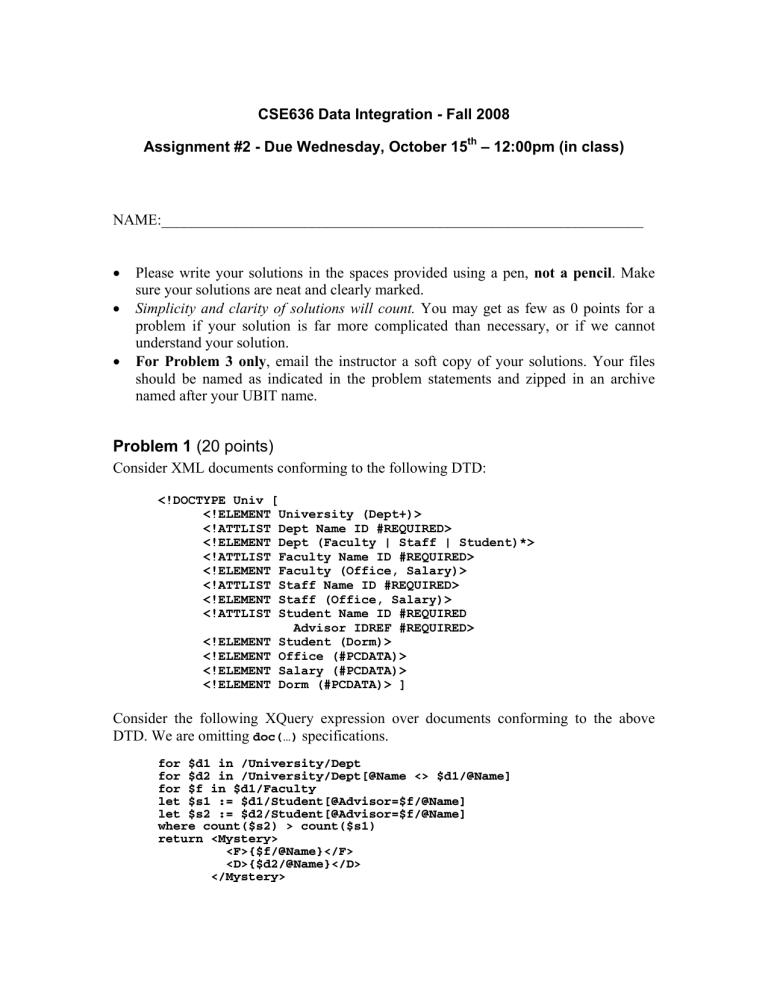
CSE636 Data Integration - Fall 2008
Assignment #2 - Due Wednesday, October 15 th
– 12:00pm (in class)
NAME:________________________________________________________________
•
Please write your solutions in the spaces provided using a pen, not a pencil . Make sure your solutions are neat and clearly marked.
•
Simplicity and clarity of solutions will count. You may get as few as 0 points for a problem if your solution is far more complicated than necessary, or if we cannot understand your solution.
•
For Problem 3 only , email the instructor a soft copy of your solutions. Your files should be named as indicated in the problem statements and zipped in an archive named after your UBIT name.
Problem 1 (20 points)
Consider XML documents conforming to the following DTD:
<!DOCTYPE Univ [
<!ATTLIST Dept Name ID #REQUIRED>
<!ELEMENT Dept (Faculty | Staff | Student)*>
<!ATTLIST Faculty Name ID #REQUIRED>
<!ELEMENT Faculty (Office, Salary)>
<!ATTLIST Staff Name ID #REQUIRED>
<!ELEMENT Staff (Office, Salary)>
<!ATTLIST Student Name ID #REQUIRED
<!ELEMENT Dorm (#PCDATA)> ]
Consider the following XQuery expression over documents conforming to the above
DTD. We are omitting doc(
…
) specifications. for $d1 in /University/Dept for $d2 in /University/Dept[@Name <> $d1/@Name] for $f in $d1/Faculty let $s1 := $d1/Student[@Advisor=$f/@Name] let $s2 := $d2/Student[@Advisor=$f/@Name] where count($s2) > count($s1) return <Mystery>
<F>{$f/@Name}</F>
<D>{$d2/@Name}</D>
</Mystery>
a.
(8 points) State in English what is computed by this query. Your answer will be graded on clarity and conciseness, as well as on correctness. b.
(4 points) Is it possible to rearrange the for and let clauses in the above query so at least one let appears before at least one for , without changing the meaning or correctness of the query? If yes, provide such a query as evidence. If no, explain why.
c.
(4 points) Can the above query produce duplicate Mystery elements in its result?
Explain why. d.
(4 points) Describe what could change in the query result if the condition [@Name <>
$d1/@Name] is removed from the second for clause. Your answer will be graded on clarity and conciseness, as well as on correctness.
Problem 2 (24 points)
Consider querying XML documents containing information about students in classes.
The documents conform to the following DTD:
<!DOCTYPE Classes [
<!ELEMENT Classes (Class*)>
<!ELEMENT Class (Topic, Students)>
<!ATTLIST Class Number ID #REQUIRED Units CDATA #REQUIRED>
<!ELEMENT Topic (#PCDATA)>
<!ELEMENT Students (Student+)>
<!ELEMENT Student (FirstNm, LastNm)>
<!ELEMENT FirstNm (#PCDATA)>
<!ELEMENT LastNm (#PCDATA)> ]>
For each of the query pairs in (a)–(e), decide if the XPath and XQuery expressions are equivalent (i.e., they are guaranteed return the same result over any XML document conforming to the above DTD). If you think they are, just write YES. If they are not equivalent (i.e., there is some document conforming to the DTD for which they will return different results), then write NO, give an example document to support your decision, and explain why the results for the XPath and the XQuery expressions are different. For equivalence don’t take into account details of answer presentation (such as
<result> tags), just consider whether the query results contain the same set of elements.
Also don’t worry about doc(…)
specifications or type coercions. a.
(4 points)
XPath:
//*[@Number="1234"]//Student
XQuery: for $c in /Classes/Class where $c/@Number="1234" return $c/Students/Student
Are the queries equivalent?
b.
(4 points)
XPath:
/Classes/Class[Students/Student[LastNm="Smith"]]/Topic
XQuery: for $c in /Classes/Class where every $n in $c/Students/Student/LastNm satisfies $n="Smith" return $c/Topic
Are the queries equivalent? c.
(4 points)
XPath:
/Classes/Class
[Students/Student/FirstNm != Students/Student/FirstNm and Students/Student/LastNm != Students/Student/LastNm]/Topic
XQuery: for $c in /Classes/Class for $s1 in $c/Students/Student for $s2 in $c/Students/Student where $s1/FirstNm != $s2/FirstNm and $s1/LastNm != $s2/LastNm return $c/Topic
Are the queries equivalent?
d.
(4 points)
XPath:
/Classes/Class[@Units="5"][3]/Topic
XQuery: for $c in /Classes/Class[3][@Units="5"] return $c/Topic
Are the queries equivalent?
e.
(4 points)
XPath:
/Classes//Student[1]
XQuery: let $s := /Classes/descendant::Student[1] return $s
Are the queries equivalent? f.
(4 points) For the same DTD, consider the following XQuery expression evaluated over a data set representing one class with 3 students. List all of the tag names that would appear in the result, including any duplicates. for $s in //(Students | Student) for $x in $s/preceding-sibling::* return name($x)
Tag names:
Problem 3 (56 points)
The CSE department has two databases containing information about students and courses. The first database contains information about undergraduate students and the courses they have taken. The root element is ugrads, with one or more student and enrollment subelements. Each student has a unique studentID and a name. Each enrollment has a courseID, a studentID and optionally the grade the student received. The second database keeps information about graduate courses and the students enrolled in them. The root element is gradCourses, with one or more course subelements. Each course has a unique courseID, a title and zero or more student elements. Each student has a studentID (unique within the enclosing course element), a name and a grade for the enclosing course. The CSE department hired you to integrate the two databases into a virtual students database. They told you that the root element has to be students with one or more student subelements. Each student should have a unique studentID, a name, a type, which should be either GRAD, for graduate students, or UGRAD, for undergraduate students, and zero or more course elements. Each course must have a courseID (unique within the enclosing student element), optionally a title, a type, which should be either GRAD, for graduate courses, or UGRAD for undergraduate courses, and a grade received by the enclosing student. The department told you that there are no data inconsistencies between the two databases, but information present in one database might be missing from the other.
a.
(18 points) Define the XML Schemas for all three databases including the appropriate keys and key references. For the undergraduate students database, place your schema in ugrads.xsd
. For the graduate courses database, place your schema in gradCourses.xsd
. Place the integrated schema in students.xsd
. b.
(38 points) Define in XQuery the GAV mapping from the two local databases to the virtual integrated one. Assume the undergraduate students database is stored in ugrads.xml
and the graduate courses database in gradCourses.xml
. Your answer will be graded on completeness, as well as on correctness. Place the GAV mapping in mapping.xq
.
